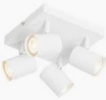- Joined
- 24 Mar 2023
- Messages
- 18
- Reaction score
- 0
- Country

Hello, just looking for some opinions on these downlight positions... I've spent days playing around with these positions...
The 2 rows of 3, they are 700 centres from the walls and then 900 centres from each other, except the middle one is 805~ centres from the 2 rows.
I've spent countless hours googling to find that most people agree 500-700 from the wall but then most people say 1200-1600 from each other and also to avoid them being over tall units. As you can see the bottom right on is more or less over the tall unit and is roughly 100mm from centre of the downlight to the edge of the tall unit. Does anyone see any problems with this? I'm also unsure as to whether the distance from the wall is too much? I've seen people say you want the downlight over the worktops or over you, but not behind you, these are fairly over you when standing at the units.
I opted for a single downlight in the centre as we will be having task lighting under the wall units and the middle half height unit is an extractor with a light, so didn't feel like downlight was necessary... but does the single centre one look odd?
Any advice would be much appreciated



The 2 rows of 3, they are 700 centres from the walls and then 900 centres from each other, except the middle one is 805~ centres from the 2 rows.
I've spent countless hours googling to find that most people agree 500-700 from the wall but then most people say 1200-1600 from each other and also to avoid them being over tall units. As you can see the bottom right on is more or less over the tall unit and is roughly 100mm from centre of the downlight to the edge of the tall unit. Does anyone see any problems with this? I'm also unsure as to whether the distance from the wall is too much? I've seen people say you want the downlight over the worktops or over you, but not behind you, these are fairly over you when standing at the units.
I opted for a single downlight in the centre as we will be having task lighting under the wall units and the middle half height unit is an extractor with a light, so didn't feel like downlight was necessary... but does the single centre one look odd?
Any advice would be much appreciated

